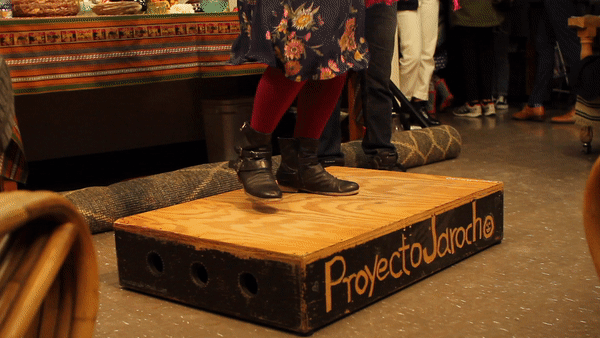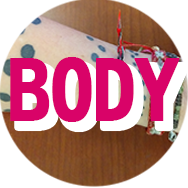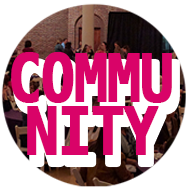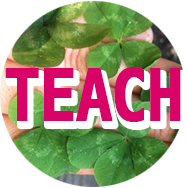Our field adopted the Students' Right to Their Own Language resolution in 1974. For decades, members of the Conference on College Composition and Communication continue to "affirm the students' right to their own patterns and varieties of language—the dialects of their nurture or whatever dialects in which they find their own identity and style." By extension, students deserve our affirmation of the patterns, varieties, identities, and styles of their multimodal compositions. As feminist teachers, we can also apply a technofeminist rhetoric of design by teaching and nurturing students to make their own cultural contexts, social networks, and embodied experience visible in their design writing.
A Student's Right to Their Own Design
Technofeminists can use our classrooms to celebrate, share, and play with a rich abundance of our visual, material, auditory, and participatory design choices. Students will bring their inspirations. They will bring their heritages. They will bring their aspirations. The communities and embodied experience in which students compose their lives can breathe life into their designs. Wajcman (2004) argued that as technology design diversifies, our technologies may then be able to better meet the needs and expectations of diverse audiences. She concluded, "if the gendered self is 'an assemblage of materials,' then women’s emancipation requires changing the woman-machine relationship to enhance women’s capacity for initiatives over machines" (p. 116). If this claim is applied specifically to design writing in composition classrooms, then our students—as this must also be extended to include a full range of diverse student bodies including race, class, sexuality as well as gender diversity—can find some freedom by enhancing their capacity to make unique choices regarding what constitutes good design from their particular contexts.
Design with the ABUNDANCE of students' visual cultures
Arola (2011) outlined her feminist heuristic to complicate and expand digital design pedagogy: "a digital feminist pedagogy must acknowledge how, embedded in an ecology of meaning and identification, design is far more than a tool for creating efficient, legible, and visually pleasing documents. Instead, design functions as a complex mode of meaning making" (p. 78). Arola offered a set of questions that guide feminists beyond the elements of design and to focus on the effects, the how of design. These questions include "consider how the design element reflects what you think, feel, believe, and value… how [does] each element reflect what you imagine your audience thinks, feels, believes, and values" (83). In these questions, Arola asks students to relate their design choices to their values, feelings, and themselves.
When I teach design writing, I actually teach students to embrace what we call "ugly" design. We look at designs and think of them in three different terms: pretty, bad, and ugly. The pretty designs are easy on the eyes, they are balanced, and they don’t make us think. The bad designs are not usable or accessible, they leave us out. And the ugly designs, those are the designs that break rules, use too much color or content, or lack balance. These designs make us see the interface and question "what was the designer thinking?"
Then we discuss what we want for our designs. The pretty designs are almost transparent. We don’t really look at them. Instead, they seem pretty because they look very much like every other design that we have seen from corporate, traditional design. This may work in a lot of contexts and for a lot of purposes. Is this all we can hope for, another pretty face in a crowd? The ugly design breaks the rules, includes too much, feels a bit punk rock or extra (as the kids say). When we want our audiences to think about our design, to really see our design choices, these ugly designs may be just what we need.
Instead of exclusively teaching professional standards of design, students learn to be inspired by their multiple communities. They are invited to integrate the visual conventions of Snapchat and Tumbr, which are often busy, bold, and even a bit awkward. Students learn to ask: What platforms shape their compositional practices? How may the place you call home be felt in your design choices?
I primarily enact this design pedagogy in my upper division Multimedia Writing course, which focuses on a multimedia storytelling project. The resulting projects are as diverse as the student body at UCSB. One particular project delighted and moved me as I watched students explore their community, values, and themselves. Karina, Milena, and Stephany, in the very first week, asked to work together because they wanted to tell a story about feminism. Karina and Stephany are Chicana and Milena is white. The project was deeply personal for both Stephany and Karina because they were exploring not only their intellectual roots but also their cultural and personal heritage. Although Milena was not studying her own cultural identity, by exploring UCSB’s deep roots and commitment to Chicana feminism, Milena also learned about the intellectual and cultural traditions that inspire her as a feminist, woman, and UCSB student.
Through the process of exploring their own personal narratives, their inspirations for design, and also exploring their communities, these young women composed A Rediscovery of Roots, which was their story of the roots of Chicana feminism at UCSB (I share this project with the consent of the students who composed it). In this story, these young women explored their own roots as Chicana feminists. Their title seems especially appropriate: like Rhodes and Alexander’s (2015) feminist rootstock, when these young women began to really dig into their lives and histories, they discovered rich intellectual traditions, activist communities, and writers like Maestras Celia Herrera Rodríguez and Cherríe Moraga, whose life work inspired the students. There was so much more below the surface, right here on campus, that they had never discovered before.
While learning and narrating their history, culture, and community, they also explored their visual culture. What design choices could they make that would make this project feel like Chicana feminism? What design choices would resonate with Chicana feminists? Answering these questions was a primary challenge. And as they developed the story, answering the design and visual questions would also shape the story.

View transcript and description of each image.
Like many students, their early work was more general and abstract, representing writing habits they have learned through their academic lives. However, as they were pushed to make design decisions, they also learned to ground their theories and their stories in the people, places, and things that make up the lived experiences of their Chicana feminism. First, they decided on colors and took inspiration from the color scheme of Chicano/a alter. Then, they communicated movement and vitality with the drawing of a dancing woman, whose dance sets the stage for the story. A major turning point in the project was drawing upon their Chicana culture: the loteria cards in which participants interpret their pasts, presence, and futures. Loteria cards were visual design elements, and so much more. Once the students more to include them, they also became framing devices for the story as a whole. As the story progresses, the students include more objects, faces, voices, and movement. By the time that the reader gets to the end of the story, we find videos and photos of dance, bright pink scarves swaying with the beat, and smiling faces as the community gathered to celebrate history, present and future of Chicana feminism at UCSB and in Santa Barbara.

This project was also personally significant to these women. In the story, they wrote
Although UCSB is a newly Hispanic Serving Institution (HSI), many Latinx students feel a deep separation from themselves and their cultural identities…UCSB's Chicanx community has experienced the struggles of assimilation, we change how we speak to navigate through this university to fit the confines of institutional white academia. It’s a different world from the one we may have left behind, with or without our families.By exploring their visual culture and pulling design from their personal experiences, the process led Stephany, Karina, and Milena to find mentors, friends, and communities enriching and inspiring. This assignment was a unique opportunity because these students had never been invited to build connections between their own lives, communities, and their academic life. The design and writing of this story helped to explore the connections between their activism, personal experience, and their identities as students and emerging scholars.






